
The light brown apple moth is a leafroller moth belonging to the lepidopteran family Tortricidae.

Actias selene, the Indian moon moth or Indian luna moth, is a species of saturniid moth from Asia. It was first described by Jacob Hübner in 1807. This species is popular among amateur entomologists and is often reared from eggs or cocoons that are available from commercial sources. They fly mainly at night.

Orgyia antiqua, the rusty tussock moth or vapourer, is a moth in the family Erebidae.
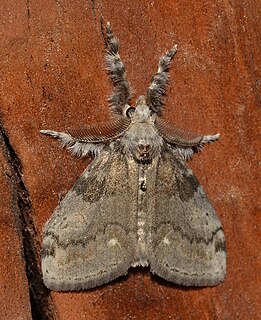
Orgyia leucostigma, the white-marked tussock moth, is a moth in the family Erebidae. The species was first described by James Edward Smith in 1797. The caterpillar is very common especially in late summer in eastern North America, extending as far west as Texas, California, and Alberta.

Aellopos titan, the Titan sphinx, is a moth of the family Sphingidae. The species was first described by Pieter Cramer in 1777.

Theretra clotho, the common hunter hawkmoth, is a moth of the family Sphingidae. It is found from Sri Lanka, India, Nepal and Myanmar, east through China to Taiwan, South Korea and Japan, and then south-east through South East Asia as far as the Lesser Sunda Islands and Timor in Indonesia. An uncommon migrant may be found up to northern China. The habitat consists of open forests, forest edges, orchards, plantations, wooded scrubs, suburban gardens and city parks.

Peridroma saucia, the pearly underwing or variegated cutworm, is a moth of the family Noctuidae. The species was first described by Jacob Hübner in 1808. It is found in North and South America, Europe, Asia and Africa. The variegated cutworm feeds on many plants, especially common fruits and vegetables. The moth undergoes two to four generations per year. The development of the moth slows in colder temperatures, indicative of its migratory nature. All stages of the life cycle have a developmental threshold for temperature. The moth is known to migrate to the northern regions during warmer months, returning to the southern regions when the climate becomes colder.
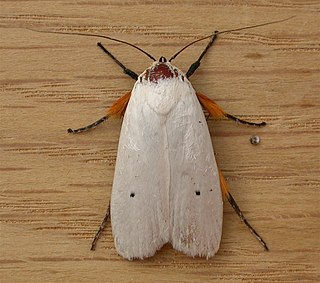
The fruit tree borer is a moth of the family Xyloryctidae. It is native to Australia.

Colias erate, the eastern pale clouded yellow, is a butterfly in the family Pieridae. It is found from south-eastern Europe, through Turkey over central Asia up to Japan and Taiwan. To the south, its range stretches to Somalia and Ethiopia. The species was first described by Eugenius Johann Christoph Esper in 1805.
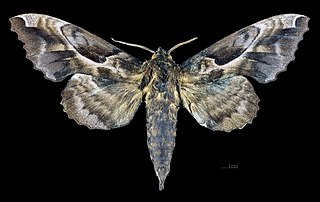
Phyllosphingia is a monotypic moth genus in the family Sphingidae erected by Charles Swinhoe in 1897. Its only species, Phyllosphingia dissimilis, the buff-leaf hawkmoth, was described by Otto Vasilievich Bremer in 1861.

Cricula trifenestrata, the cricula silkmoth, is a species of wild silk moth of the family Saturniidae. It is found from India to the Philippines, Sulawesi, Java, and Sri Lanka.

Ambulyx ochracea, the ochreous gliding hawkmoth, is a moth of the family Sphingidae. The species was first described by Arthur Gardiner Butler in 1885.
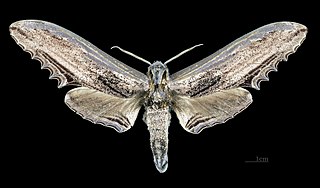
Langia zenzeroides, the apple hawkmoth, is a moth of the family Sphingidae. It was described by Frederic Moore in 1872.

Marumba sperchius is a species of moth of the family Sphingidae first described by Édouard Ménétries in 1857.
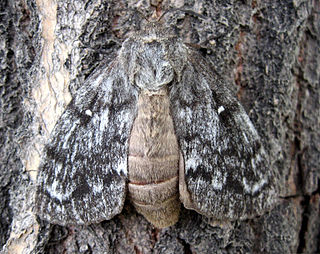
Dendrolimus superans, also called the white-lined silk moth, Sakhalin silk moth, Japanese hemlock caterpillar, Siberian silk moth, Siberian moth, Siberian conifer silk moth, Siberian lasiocampid or larch caterpillar, is a moth of the family Lasiocampidae.

Oraesia emarginata is a species of moth of the family Erebidae first described by Johan Christian Fabricius in 1794. It is found in Australia, New Caledonia, Indonesia, New Guinea, Pakistan, the Philippines, India, Sri Lanka, Sulawesi, Taiwan, China, Japan, Korea and Nepal as well as Eritrea, Ethiopia, Kenya, Namibia, Nigeria, South Africa, Tanzania, the Gambia, Uganda, Oman and Yemen.

Orgyia pseudotsugata, the Douglas-fir tussock moth, is a moth of the subfamily Lymantriinae first described by James Halliday McDunnough in 1921. It is found in western North America. Its population periodically irrupts in cyclical outbreaks. The caterpillars feed on the needles of Douglas fir, true fir, and spruce in summer, and moths are on the wing from July or August to November.

Orgyia postica, the cocoa tussock moth or hevea tussock moth, is a species of moth of the subfamily Lymantriinae of family Erebidae found from the Oriental tropics of India, Sri Lanka, Myanmar, Borneo, Java, New Guinea and Taiwan. It was described by Francis Walker in 1855.
Sparganothoides ocrisana is a species of moth of the family Tortricidae. It is found in Costa Rica, Guatemala and Veracruz in Mexico.
Pandemis pyrusana, the apple pandemis or pandemis leafroller moth, is a species of moth of the family Tortricidae. The species was first described by William D. Kearfott in 1907. It is found in North America, where it has been recorded from Alberta to British Columbia, south through Idaho, Utah and Colorado and California. The habitat consists of forests with deciduous trees and shrubs.





















